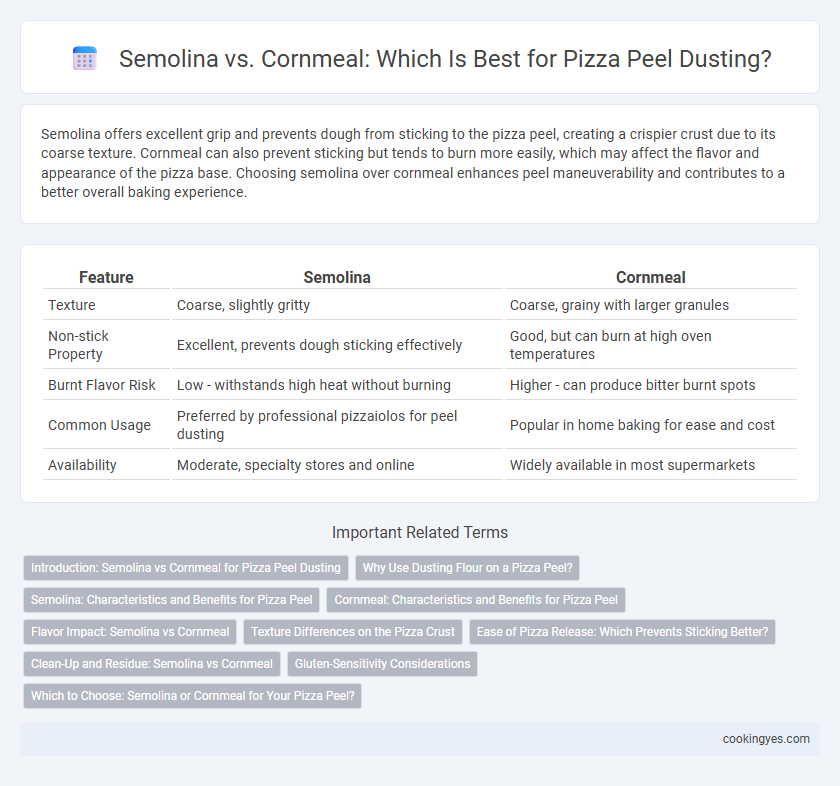Semolina offers excellent grip and prevents dough from sticking to the pizza peel, creating a crispier crust due to its coarse texture. Cornmeal can also prevent sticking but tends to burn more easily, which may affect the flavor and appearance of the pizza base. Choosing semolina over cornmeal enhances peel maneuverability and contributes to a better overall baking experience.
Table of Comparison
| Feature | Semolina | Cornmeal |
|---|---|---|
| Texture | Coarse, slightly gritty | Coarse, grainy with larger granules |
| Non-stick Property | Excellent, prevents dough sticking effectively | Good, but can burn at high oven temperatures |
| Burnt Flavor Risk | Low - withstands high heat without burning | Higher - can produce bitter burnt spots |
| Common Usage | Preferred by professional pizzaiolos for peel dusting | Popular in home baking for ease and cost |
| Availability | Moderate, specialty stores and online | Widely available in most supermarkets |
Introduction: Semolina vs Cornmeal for Pizza Peel Dusting
Semolina and cornmeal are popular choices for pizza peel dusting, each offering unique benefits in preventing dough from sticking. Semolina, made from durum wheat, provides a coarse texture that allows the pizza to slide easily while imparting a subtle nutty flavor. Cornmeal, with its slightly grittier texture, adds a crispy, slightly toasted finish to the pizza crust edges.
Why Use Dusting Flour on a Pizza Peel?
Using dusting flour such as semolina or cornmeal on a pizza peel prevents dough from sticking during transfer to the oven, ensuring a smooth slide and maintaining the pizza's shape. Semolina's coarse texture offers excellent grip and durability under heat, while cornmeal adds a slightly crunchy texture and prevents sticking without burning easily. Choosing the right dusting flour enhances pizza handling efficiency and contributes to a crispier, well-cooked crust.
Semolina: Characteristics and Benefits for Pizza Peel
Semolina, a coarse-ground durum wheat flour, offers an ideal texture for pizza peel dusting, providing a slightly abrasive surface that prevents dough from sticking without burning quickly. Its high protein content enhances its resistance to heat, ensuring smooth sliding of pizza from peel to oven. Using semolina maintains the integrity of the dough while promoting an even bake and crisp crust, making it a preferred choice over cornmeal for professional and home pizza makers.
Cornmeal: Characteristics and Benefits for Pizza Peel
Cornmeal provides excellent slip resistance and prevents dough from sticking to the pizza peel, ensuring smooth transfer into the oven. Its coarse texture creates a thin barrier of air beneath the dough, promoting crispier crusts and enhancing overall bake quality. The yellow hue of cornmeal can also add a subtle visual appeal to the pizza's base.
Flavor Impact: Semolina vs Cornmeal
Semolina imparts a subtle nutty flavor and a slightly coarse texture to the pizza crust, enhancing the overall taste experience with a mild, toasted grain note. Cornmeal offers a distinctively crunchy texture and a sweeter, earthy flavor that adds a unique character to the pizza base. Choosing between semolina and cornmeal affects not only the pizza's texture but also the flavor profile, with semolina providing a more restrained graininess and cornmeal delivering a bolder, slightly sweet finish.
Texture Differences on the Pizza Crust
Semolina creates a coarser and crunchier texture on the pizza crust due to its larger grain size, enhancing the crust's crispness and oven spring. Cornmeal produces a grittier mouthfeel with a slightly sweeter flavor, offering a unique texture contrast without absorbing much moisture. Choosing semolina or cornmeal affects the crust's overall bite and how it releases from the peel during baking.
Ease of Pizza Release: Which Prevents Sticking Better?
Semolina's granular texture provides excellent ease of pizza release on a peel, minimizing sticking and allowing the pizza to slide off smoothly. Cornmeal, while also effective, tends to absorb moisture more quickly, which can sometimes cause the dough to stick, especially with high-hydration crusts. Professional pizzaiolos often prefer semolina for its superior ability to prevent sticking and maintain a clean peel surface during transfer.
Clean-Up and Residue: Semolina vs Cornmeal
Semolina creates minimal residue on pizza peels, resulting in easier clean-up compared to cornmeal, which can leave a gritty texture and stubborn crumbs behind. The finer particles of semolina reduce sticking and prevent excessive flour dust from accumulating on surfaces. Choosing semolina enhances both peel maintenance and the overall pizza-making experience by minimizing mess and residue.
Gluten-Sensitivity Considerations
Semolina and cornmeal differ significantly in gluten content, with semolina derived from wheat and containing gluten, posing challenges for gluten-sensitive individuals. Cornmeal, made from ground corn, is naturally gluten-free and preferred for dusting pizza peels to prevent dough sticking without gluten exposure. Using cornmeal reduces the risk of cross-contamination for those with celiac disease or gluten intolerance while still providing a coarse texture that facilitates easy pizza transfer.
Which to Choose: Semolina or Cornmeal for Your Pizza Peel?
Semolina offers a coarse texture that provides excellent grip, preventing dough from sticking to the pizza peel while imparting a subtle nutty flavor. Cornmeal is more granular and can create a crunchier bottom crust, but it sometimes burns faster under high heat, potentially affecting taste. Choosing between semolina and cornmeal depends on whether you prioritize ease of handling and flavor (semolina) or a crispier crust texture (cornmeal) for your pizza.
Semolina vs Cornmeal for pizza peel dusting Infographic

 cookingyes.com
cookingyes.com